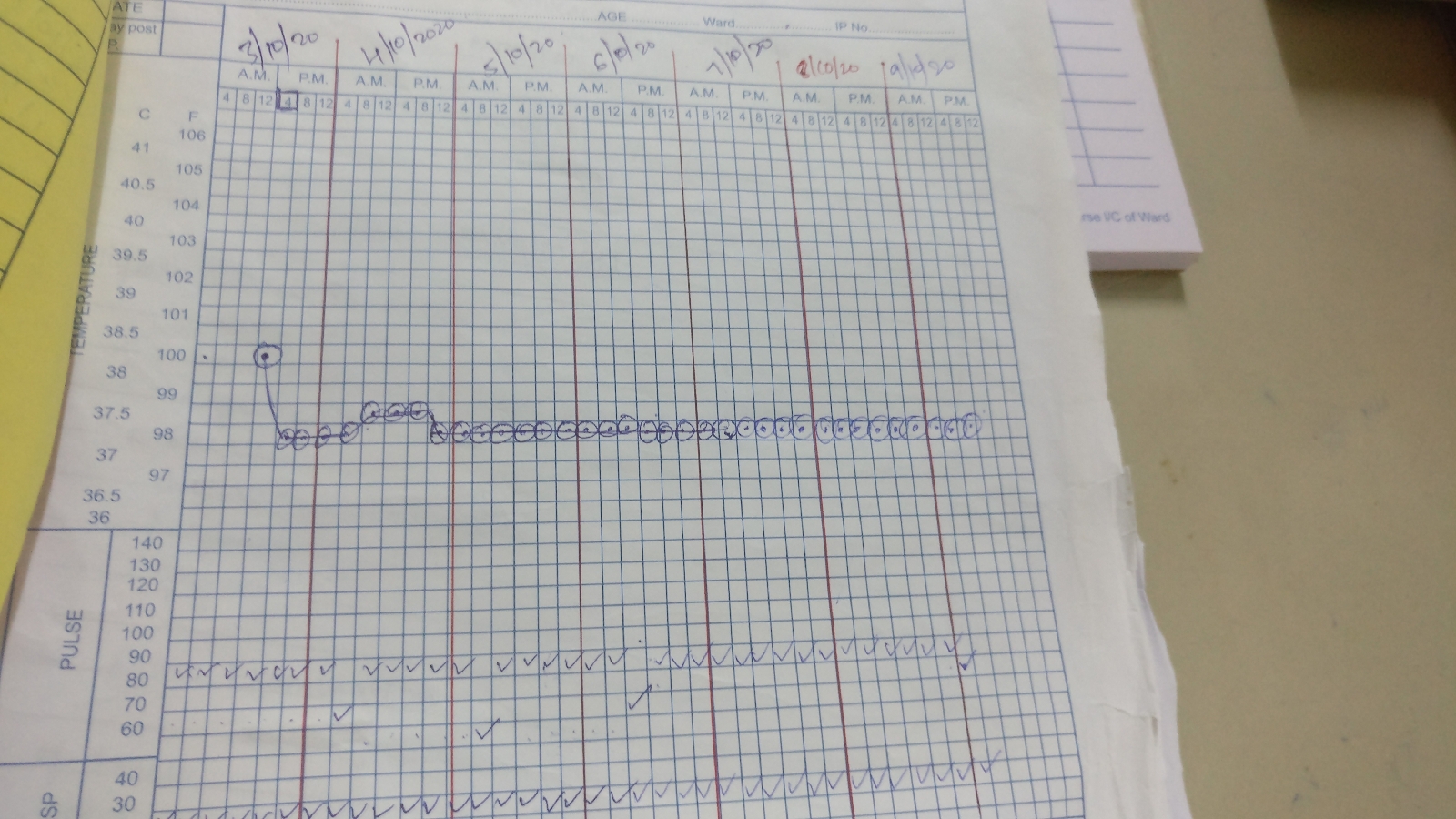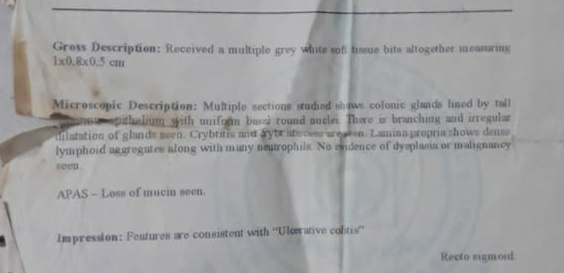November bimonthly assessment exam
CASE : 1
1) "55 year old male patient came with the complaints of Chest pain since 3 days Abdominal distension since 3 days Abdominal pain since 3 days and decreased urine output since 3days and not passed stools since 3days.
A) Where are the different anatomical locations of the patient's problems and what are the different etiologic possibilities for them? Please chart out the sequence of events timeline between the manifestations of each of these problems and current outcomes.
ANATOMICAL LOCATIONS WITH ETIOLOGY:
GIT (Pain abdomen) :
Etiology: Pancreatitis secondary to ? chronic alcoholism
KIDNEYS (Oliguria) :
Etiology: AKI (pre renal due to fluid loss in pancreatitis)
Sepsis induced ATN
HEART / LUNGS (SOB) :
Etiology: AKI leading to fluid overload and heart failure.
Pancreatitis leading to pleural effusion / ?ARDS
GIT (Constipation) :
Etiology: ? paralytic ileus secondary to pancreatitis
Sequence of events
A.diaphyseal dysplasia of both tibia
B.patient is a alcoholic and smoker since 30years
C.patient has an atherosclerotic vascular disease of right upper limb
D.patient presented with chest pain,sob, decreased urine output(due to AKI secondary to sepsis),constipation(due to paralytic ileus),abdominal distension
He was diagnosed with acute severe pancreatitis(supported by clinical,USG findings and raised serum amylase levels) secondary to gall stones with AKI ,rt pleural effusion
E.patient was started on inj.lasix and iv antibiotics,after 1day pedal edema and sob decreased.after one moreday patient was in altered sensorium,on the same day patient was taken for hemodialysis 1st session.after hemodialysis his urea and creat values have come down(7.4 to 5.3)and sensorium improved.
F.After 2days patient was taken for one more session of dialysis (his creat 5.9 to 4.4) but his total leukocyte counts have been raised ?Central line sepsis.
G.within 24hrs of 2nd session of dialysis his creat increased again to 5.4 and patient had 8episodes of vomitings and was intolerant to oral feeds.
B) What are the pharmacological and non pharmacological interventions used in the management of this patient and what are the efficacy of each one of them?
PHARMACOLOGIC :
https://link.springer.com/article/10.1007/s00534-005-1050-8
1.FLUID REPLACEMENT :
Increased vascular permeability in acute pancreatitis causes the loss of intravenous fluid and reduces plasma volume. In severe cases, in patients with massive ascites, pleural effusion, and retroperitoneal and mesenteric edema, circulating plasma volume decreases markedly. Hypovolemia may lead to shock and acute renal failure, and, because hypovolemic shock may impair the pancreatic microcirculation and promote pancreatic ischemia and necrosis, restoration and maintenance of plasma volume is crucial in severe acute pancreatitis.
2.ANTIBIOTICS : No role in non necrotizing / sterile pancreatitis
3.TRAMADOL : For pain management
4.ZOFER : For vomitings
5.PANTOP : To prevent gastritis and further damage to pancreas by inhibiting gastrin
6.LASIX : For fluid overload
7.NEBULIZATION : For wheezing and crepts
NON PHARMACOLOGIC :
1.NIL PER ORAL
https://pubmed.ncbi.nlm.nih.gov/27107634/
2.RYLES TUBE ASPIRATION
3.OXYGENATION
2) A 55 year old male, shepherd by occupation, presented to the OPD with the chief complaints of fever (on and off), loss of appetite, headache, body pains, generalized weakness since 2 months, cough since 2 weeks and vomitings and pain abdomen since 2 days.
https://aakansharaj.blogspot.com/2020/11/55-year-old-male-with-anemia.html?m=1
A) Where are the different anatomical locations of the patient's problems and what are the different etiologic possibilities for them? Please chart out the sequence of events timeline between the manifestations of each of these problems and current outcomes.
ANATOMICAL LOCATIONS WITH ETIOLOGY:
Etiology: Multiple myeloma
1) Bone marrow - due to marrow infiltration anemia,leucopenia,thrombocytopenia
2)lytic bone lesions pepper pot skull
3)renal failure - Excess monoclonal immunoglobulin can cause hyperviscosity, platelet dysfunction and renal tubular damage, leading respectively to neurologic derangement, bleeding, and renal failure.
excess production of monoclonal light chains (light- chain cast nephropathy), deposition of intact light chains causing nephrotic syndrome, light chain amyloidosis, hypercalcemia, hyperuricemia, dehydration.
These patients can also have bleeding manifestations due to thrombocytopenia and anitbody coated platelets which are defective.
5) Head ache ,paresthesia and blurring of vision- are features of hyper viscosity.
6) Lungs : showing Moderate to gross right pleural effusion and Multilobar consolidations of the right lung, involving upper and middle lobes With Passive collapse of basal segments of right lower lobe
Pneumonia is because of immunodeficiency state ,as the immunoglobulins produced are defective.
Pleural fluid analysis showing exudative picture suggesting parapneumonic effusion.
Sequence of events
-Alcohol & smoking (35 years)
-Stopped alcohol (4 years)
-Fever , generalised weakness & anemia - 2 units blood transfusion (1.5 years)
-Stopped smoking (4 months)
-Low grade fever , generalized weakness , headache , neck pain , loss of appetite , weight loss (2 months)
-Cough & SOB (2 weeks)
-Vomiting & pain abdomen (2 days)
A) pharmacological interventions
1) Antibiotics (?aytpical pneumonia-azithromycin)
https://www.intechopen.com/books/update-on-multiple-myeloma/infections-in-patients-with-multiple-myeloma-in-the-era-of-novel-agents-and-stem-cell-therapies
However, the infections encountered in patients with MM include: (1) bacterial infections, hu involving respiratory and urinary tract, caused by Streptococcus pneumonia, Staphylococcus aureus, Haemophilus influenzae, Klebsiella pneumonia, Escherichia coli, Pseudomonas aeruginosa, and Enterobacteriaceae; (2) viral infections caused by herpes simplex virus (HSV), VZV, and cytomegalovirus (CMV); (3) fungal infections caused by Candida species and Aspergillus species; and (4) Pneumocystis jiroveci pneumonia
2.ATT : For TB
3.SEVELAMER : For hyperphosphatemia
4.FEBUXOSTAT : For hyperuricemia
5.PRBC transfusion for anemia
B)non pharmacological
Pleural fluid analysis
Imaging -xray skull, hrct chest
Serum electrophoresis,sputum culture
3) 51 Year old man with complaints of B/L pitting pedal edema from 5 to 6months,abdominal distension from 2 to 3 days,SOB from 3days.
nithishaavula.blogspot.com/2020/11/51-yr-old-male-with-hfref.html?m=1
A) Where are the different anatomical locations of the patient's problems and what are the different etiologic possibilities for them? Please chart out the sequence of events timeline between the manifestations of each of these problems and current outcomes.
ANATOMICAL LOCATIONS WITH ETIOLOGY:
1)pedal edema with abdominal distention with sob suggestive of right heart failure or renal failure
B)etilogy of rt heart failure
https://www.ncbi.nlm.nih.gov/books/NBK459381/
Chronic conditions of pressure overload may lead to RVF. These include:
* Primary pulmonary arterial hypertension (PAH) and secondary pulmonary hypertension (PH) as seen in chronic-obstructive pulmonary disease (COPD) or pulmonary fibrosis)
* Congenital heart disease (pulmonic stenosis, right ventricular outflow tract obstruction, or a systemic RV).
The following conditions result in volume overload causing RVF:
* Valvular insufficiency (tricuspid or pulmonic)
* Congenital heart disease with a shunt (atrial septal defect (ASD) or anomalous pulmonary venous return (APVR)).
Another important mechanism that leads to RVF is intrinsic RV myocardial disease.
This includes:
* RV ischemia or infarct
* Infiltrative diseases such as amyloidosis or sarcoidosis
* Arrhythmogenic right ventricular dysplasia (ARVD)
* Cardiomyopathy
* Microvascular disease.
Lastly, RVF may be caused by impaired filling which is seen in the following conditions:
* Constrictive pericarditis
* Tricuspid stenosis
* Systemic vasodilatory shock
* Cardiac tamponade
* Superior vena cava syndrome
* Hypovolemia.
SEQUENCE OF EVENTS:
- Tobacco chewing (40 years)
- Alcohol (10 years)
- DM (7 years)
- HTN (5 years)
- 1st Episode GTCS (3 years) & AF with HFpEF
- 2nd Episode GTCS (2 years)
- HFrEF & Anasarca (1 year) - (subsided with medication)
- Pedal edema (6 months)
- Increased pedal edema , abdominal distention , SOB and decreased urine output (3 days)
- Admitted
- Complaints resolved and discharged
b) What are the pharmacological and non pharmacological interventions used in the management of this patient and what are the efficacy of each one of them?
Preload reducing agents - Diuretics (only if symptomatic)
Afterload reducing agents - vaso dilators ,ace inhibitors and arb
Beta blockers for preventing cardiac remodeling and reduce mortality.
https://pmj.bmj.com/content/79/937/634
Antiepileptics ( known case of epilepsy)
Insulin for glycemic control in diabetes.
- Non pharmacological interventions
Salt and fluid restriction
https://pubmed.ncbi.nlm.nih.gov/23787719/
Individualized salt and fluid restriction can improve signs and symptoms of CHF
Case 4
31 yr old man with B/L pedal edema with scrotal and penile swelling since 2 months
https://nairaditya97.blogspot.com/2020/11/31-yr-old-male-with-bl-pedal-edema-with.html?m=1
a) Where are the different anatomical locations of the patient's problems and what are the different etiologic possibilities for them? Please chart out the sequence of events timeline between the manifestations of each of these problems and current outcomes.
1.Patient is a chronic alcoholic which causes wet beri beri(heart failure due to thiamine deficiency)
2.peripheral neuropathy due to thiamine deficiency
Wet beriberi is one of the clinical syndromes associated with thiamine deficiency. Thiamine, in its phosphorylated form thiamine pyrophosphate (TPP), is the precursor for the cofactor of both pyruvate dehydrogenase and alpha-ketoglutarate dehydrogenase, which are both key enzymes of the Krebs cycle. The Krebs cycle is an essential part of aerobic glucose metabolism. A decrease in the activity of these 2 enzymes due to thiamine deficiency may lead to the tissue accumulation of pyruvate and lactate.[1] Moreover, the accumulation of pyruvate and lactate decreases peripheral resistance and increases venous blood flow, increasing the cardiac preload. Increased preload and myocardial dysfunction ultimately leads to congestive heart failure.[2,3] Wet beriberi mainly triggers right heart failure.[4–6] The moderate pulmonary hypertension is common for wet beriberi patient.[3,4,7
https://www.ncbi.nlm.nih.gov/pmc/articles/PMC5851725/
EVENTS TIME LINE:
- Alcohol & khaini (3 years)
- Pins and needles (1 year)
- Palpitations and sob on exertion (8 months)
- PND (6months)
- Sexual disturbance and constipation (3months)
- Pedal edema and Scrotal edema(2 months)
- Admitted
CURRENT OUTCOME:
Completly relieved of his symptoms as the wet beriberi resolved.
B) What are the pharmacological and non pharmacological interventions used in the management of this patient and what are the efficacy of each one of them?
PHARMACOLOGIC :
1.LASIX : Mortality: 3 placebo-controlled trials (n=221) reported data; the OR was 0.25 (95% confidence interval, CI: 0.07, 0.84, P=0.03), representing an absolute risk reduction of 8% in mortality in patients treated with diuretics compared to placebo.
Worsening of heart failure: 4 placebo-controlled trials (n=448) and 4 active-controlled trials (n=177) reported data. The OR was 0.31 (95% CI: 0.15, 0.62, P=0.001) for the placebo-controlled trials and 0.34 (95% CI:0.10, 1.21, P=0.10) for the active-controlled trials.
https://www.ncbi.nlm.nih.gov/books/NBK69174/
2.THIAMINE : In the study by Schoenenberger and colleagues (n=9), patients who took thiamine had 3.30% (95% confidence interval [CI]: 0.63%, 5.97%) greater LVEF compared to those on placebo.
Likewise, Shimon et al reported that thiamine resulted in 2.20% greater LVEF than the placebo group (n=29), although the extra improvement was not significant (95% CI: −18.97, 23.37%).
In our meta analysis, thiamine supplementation resulted in a significantly improved net change in LVEF (3.28%, 95% CI: 0.64%, 5.93%) compared with placebo.
https://www.ncbi.nlm.nih.gov/pmc/articles/PMC3865826/#:~:text=Compared%20with%20placebo%20(2%20trials,0.64%25%2C%205.93%25).
3.TELMISARTAN : For afterload reduction in heart failure
NON PHARMACOLOGIC :
1.SALT AND FLUID RESTRICTION :
https://pubmed.ncbi.nlm.nih.gov/23787719/
Individualized salt and fluid restriction can improve signs and symptoms of CHF with no negative effects on thirst, appetite, or QoL in patients with moderate to severe CHF and previous signs of fluid retention.

